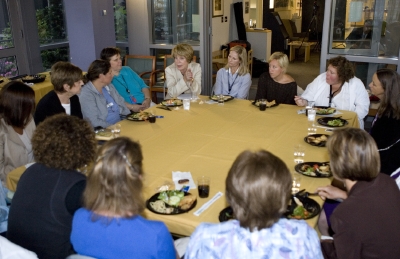Restructured Committees Launched

BWH CNO Mairead Hickey, PhD, RN, at top left, kicked off the Nursing Department’s resturctured committee program in September by bringing the co-chairs and advisors of the four committees together for lunch.
The BWH Department of Nursing in September kicked off a restructured committee program as Mairead Hickey, PhD, RN, chief nursing officer and senior vice president of Patient Care Services, welcomed the newly appointed leaders of each committee.
“Our goal in reshaping and expanding committees is to effectively bring together the professional nursing community at BWH with representation from nurses in varying roles and from different practice areas to deliberate, shape and make decisions about issues related to clinical practice, patient and family care, informatics and clinical innovation and safety, quality and care improvement,” Hickey said.
The Department of Nursing is guided by the belief that clinical nurses engaged in direct care of patients and families have a central role and responsibility to help develop a practice environment that supports excellent patient and family care. Systems and processes that support participative decision making and highly effective teamwork are important characteristics of practice environments that facilitate excellence. Therefore, a cornerstone of the BWH Department of Nursing committee structure is the engagement of clinical nurses and nurse managers to promote open dialogue, clinical inquiry, shared decision making and continuous learning.
“We continuously strive to understand what is needed to give patients and families the care they require and to make sure nurses have the resources required to provide that care,” Hickey said. “I will look to these committees to help inform the core work of the Department of Nursing.”
This new structure begins with four committees: 1.) Standards, Policies and Procedures; 2.) Patient and Family Education; 3.) Safety, Quality and Care Improvement and 4.) Informatics and Clinical Innovations. Two of these committees, Standards, Policies and Procedures and Informatics and Clinical Innovations, already have a successful track record, and their membership has been redesigned to accommodate new members, especially clinical nurses.
These four committees are comprised of more than 75 BWH nurses, and almost half of them are staff nurses. Each committee has two co-chairs, who are responsible for setting committee agenda and facilitating group work to achieve goals, and one or two advisors, who guide the development of the co-chairs and connect committee work and departmental or organizational work. Members represent their role, area of clinical expertise and peer group, and they are responsible for bringing issues back to their units or areas to inform and engage other clinical nurses in the work of the committee.
The committees report to the Nursing Coordinating Committee, which will ensure that the work and interdependencies of each committee are integrated and aligned with Nursing Department goals. The committee co-chairs and advisors are members of this group. The Nursing Coordinating Committee reports into the Nursing Executive Board (NEB).
Each issue of BWH Nurse will feature a committee column updating you on the progress of each committee.
“This structure facilitates the ability of committee members to engage their nurse colleagues throughout BWH in thoughtful and meaningful discussion about clinical practice and the care environment in a way that influences and enhances decision making,” Hickey said.
